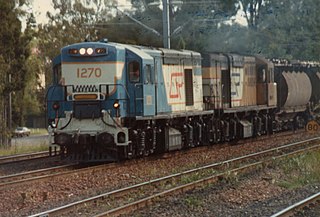
An electric locomotive is a locomotive powered by electricity from overhead lines, a third rail or on-board energy storage such as a battery or a supercapacitor.

Queensland Rail, also known as QR, is a railway operator in Queensland, Australia. Owned by the Queensland Government, it operates suburban and long-distance passenger services, as well as owning and maintaining approximately 6,600 kilometres of track.

The 3000/3100 class are a class of diesel railcars operated by the State Transport Authority and its successors in Adelaide. They were built by Comeng and Clyde Engineering between 1987 and 1996.

The Queensland rail network, the first in the world to adopt 1,067 mm narrow gauge for a main line, and now the second largest narrow gauge network in the world, consists of:

The 46 class was a class of mainline electric locomotive built by Metropolitan-Vickers and its partner Beyer, Peacock and Company in England for the New South Wales Government Railways.
The New South Wales 85 class were a class of 10 electric locomotives built by Comeng, Granville between May 1979 and July 1980 for the Public Transport Commission.

The 1300 class were a class of diesel locomotive built by English Electric, Rocklea for Queensland Rail between 1967 and 1972. They were later sold to AN Tasrail.

The GT42CU AC is a model of diesel electric locomotives manufactured by EDi Rail, Maryborough between 1999 and 2005 under licence from Electro-Motive Diesel, for use on narrow gauge railways in Queensland.

The Blackwater railway system is located in Central Queensland and services the coal mining area of the Bowen Basin. It carries coal, as well as products, to other destinations by way of connections to the North Coast Line at Rocklands and the Goonyella Line via Gregory coal mine to Oaky Creek. Together with the Moura line the two railway systems are known as the Capricornia Coal Chain.
In the late 1970s and 1980s, a significant rail electrification program was completed in the Australian state of Queensland. The electrified Queensland network is the largest in Australia with over 2,000 kilometres electrified, the next biggest is New South Wales with 640 kilometres, that is served mainly as passenger operations.

The GT42CU ACe is a model of diesel electric locomotives manufactured by EDi Rail, Maryborough between 2007 and 2013 under licence from Electro-Motive Diesel, for use on narrow gauge railways in Queensland, South Australia and Western Australia.

The 3100/3200 class are a class of electric locomotives built by Comeng, Rocklea for Queensland Rail between 1986 and 1989.
The 3300/3400 class are a class of electric locomotives built by Clyde Engineering, Kelso and Somerton for Queensland Rail in 1994-1995.

The 3500/3600 class are a class of electric locomotives built by Walkers Limited, Maryborough for Queensland Rail between 1986 and 1988.

The 3900 class are a class of electric locomotives built by Walkers Limited, Maryborough for Queensland Rail between 1988 and 1990.

The 1270 class were a class of diesel locomotive built by English Electric, Rocklea for Queensland Railways between 1964 and 1966.

The 2100 class was a class of diesel locomotives built by Clyde Engineering, Eagle Farm for Queensland Railways between 1970 and 1973.

The Queensland Railways 2170 class is an Australian diesel-electric locomotive.

The 2800 class are a class of diesel locomotive built by A Goninan & Co, Townsville for Queensland Rail between 1995 and 1998.






























